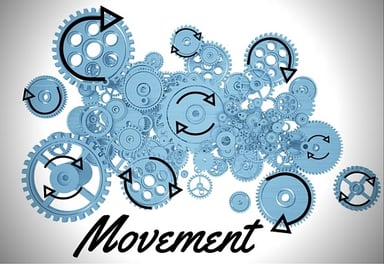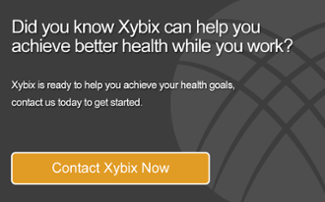 During the summer, most of us are guilty of loosening up the reigns on our diet and exercise plans. Kids are out of school and the weather is optimal, so who wouldn’t consider every other day to be a “cheat” day? Of course, the all-American summer is not complete without grilled meals, adult beverages, and tasty sweets, but when you’re back at the grind, maybe “the itis” is still lingering.
During the summer, most of us are guilty of loosening up the reigns on our diet and exercise plans. Kids are out of school and the weather is optimal, so who wouldn’t consider every other day to be a “cheat” day? Of course, the all-American summer is not complete without grilled meals, adult beverages, and tasty sweets, but when you’re back at the grind, maybe “the itis” is still lingering.
Can you even help it? After all, you’re connected to a desk and a chair all day! You may be thinking, “But I’ve got a height adjustable desk. I stand throughout the day--that’s enough.”
Sorry friends, standing at work helps, but it’s definitely not enough. While there are many benefits to taking the time to stand at work, it's movement throughout the day that is the real trick to fighting off high levels of blood sugar and cholesterol.
It’s not brain science; it’s actually quite simple. When you move your muscles, you’re consuming sugars, and during the summer, we’re all guilty of indulging in cold, sweet treats. Even too much fruit can actually be harmful to your blood sugar levels. Even if you don’t have a sweet tooth, many 911 dispatchers confess they find themselves mindlessly snacking throughout the day. This is totally understandable – most days are filled with five minutes of intense conversation followed by an hour of lull or low emergency calls. To combat bad snacking habits, try to trade one or two snacks for extra water and MOVEMENT.
To help you out even further, here are four additional tips to help fight the summer bloating (or to keep you moving ANY day):
For the Overachiever:
You would probably dance at your desk if it were allowed, or maybe you’re just really health conscious and get antsy at your desk. Whatever the case, you can try:
-
Squats:
-
Place your feet shoulder-width apart or slightly wider.
-
Sit back and down like you're sitting into an imaginary chair.
-
Lower down so your thighs are as parallel to the floor as possible with your knees over your ankles.
-
Press your weight back into your heels.
-
Keep your body tight, and push with your heels to bring yourself back to the starting position.
-
Repeat.
-
Lunges:
-
Keep your upper body straight, your shoulders back and relaxed, and your chin up.
-
Step forward with one leg, lowering your hips until both knees are bent at about a 90-degree angle.
-
Return to standing position and repeat with other leg.
For the Discrete Worker:
You might be the only one standing and want to keep moving without attracting a lot of attention. No worries; you can try:
-
Calf raises:
-
Stand with your feet flat on the ground, and elevate your body so that you’re standing on the balls of your feet and your heels are off of the ground. Your calf muscles should feel tight.
-
Lower your body and relax the calves.
-
Repeat.
-
Toe touches:
-
Stand with your feet shoulder-length apart.
-
Extend your right leg and point with your toe in front of you. Try to imagine pointing at something on the ground in front of you with your big toe.
-
Bring your right leg back to a standing position and repeat with other leg.
-
Repeat (alternate feet quickly like a soccer player for a “cardio burn”).
For the Limited Movement Worker:
Maybe you simply want to start out slow, or perhaps you have a previous injury/illness that prevents certain movements. Either way, give the following exercises a shot:
-
Shoulder shrug:
-
Stand up straight in good posture.
-
Lift your chest and inhale.
-
Keeping your arms straight, shrug your shoulders straight up toward your ears as high as you can.
-
Hold this uppermost position for one to two seconds (do not roll your shoulders backward).
-
Exhale and lower your shoulders back down.
-
Ankle Stretches
-
This exercise can be done sitting down.
-
Stretch your leg out and keep it steady.
-
Move your ankle/foot as far up and down as you can go without it being painful.
-
Move your ankle/foot as far as you can to both sides (to the left and to the right) without feeling any pain.
-
Repeat with your other leg.
For the Yoga Enthusiast:
Do you like slow and controlled moving poses? No problem! Try:
-
Tree pose:
-
Stand with your arms at your sides and your feet flat.
-
Lift one leg and bend the knee.
-
Reach down and clasp the inner ankle.
-
Use your hand to bring your right foot alongside your inner thigh.
-
Press your palms together in a prayer position at your chest, with your thumbs resting on your sternum.
-
Bring your leg down slowly and repeat with the other leg.
-
Chair Pose:
-
Stand with your feet flat.
-
Inhale and raise your arms perpendicular to the floor.
-
Exhale and bend your knees, trying to make the thighs as nearly parallel to the floor as possible. The knees will project out over the feet, and the torso will lean slightly forward over the thighs until the front torso forms approximately a right angle with the tops of the thighs.
-
Keep the inner thighs parallel to each other, and press the heads of the thigh bones down toward the heels.
*As always, it’s a good idea to check with your doctor before starting any new physical fitness regime.
Moving During the Day Could Mean Less Gym Time
These movements are obviously not just for post-BBQ bloating, and there are tons of ways to stay active while at your standing desk. You can try any combination of these stretches and exercises. The key is to keep yourself moving throughout your day. Remember, an hour of exercise at the gym does not offset a day of sitting. Crazy, right? It’s even crazier to think that Dr. Francisco Lopez-Jimenez, director of preventive cardiology at the Mayo Clinic in Rochester, is suggesting that enough movement during the day could negate going to the gym. Take a look at what he has to say on the subject:
“If we can manage to build more movement into our everyday activities, it might even be possible to skip the gym, although research is needed to address this possibility,” Lopez-Jimenez said. "If you barely sit during the day, do you really have to exercise to be healthy?"
Like he said, the research is not there yet, but he makes a strong effort to point out the benefits of moving (not just standing) at work. Not only can an eight or twelve hour shift in a comm center be used to save lives, but it can help save your own life as well.



